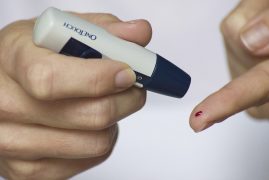Diabetes mellitus, whose medical name is diabetes, is accepted as a problem threatening the health of millions of people all over the world. The main cause of diabetes, which can develop due to nutritional habits, genetic factors and many other factors, is the insufficiency or dysfunction of the insulin hormone, which acts as a key for the use of glucose in the blood in cells. However, before making the definition of the disease, it will be useful to examine the factors causing the disease.
Blood Sugar Level and Insulin
Glucose, known as blood sugar, is essential for the body to function well. Glucose is absorbed by some cells in the blood and energy is provided to the body in this way. The brain, muscles, and even the muscles that make our heart beat work by converting sugar into energy in cells. The hormone that causes the sugar to enter the cells is the hormone called insulin secreted from the pancreas. Glucose is one of the energy sources in the body, and some cells in the blood can only use sugar as an energy source. Glucose balance is especially important for brain cells, nerve cells and red blood cells.
In order to provide healthy energy to the body, there must be a balance between glucose and insulin release. Insulin is produced in the pancreas, and the amount of production largely depends on the glucose ratio. As blood sugar rises, the pancreas produces insulin, and when glucose reaches normal levels, insulin production decreases. Diabetes is caused by an imbalance between insulin and glucose.
If insulin production is low compared to blood sugar, the produced insulin will not be sufficient to use it for all cells that need sugar. In this case, glucose becomes impossible to use by blood cells, and it begins to circulate in the blood free. Glucose, which is not absorbed, creates a poison effect on the body and destroys the cells in the first stage and organs in the next process. Diabetes is the result of such a process.
What are the Symptoms of Diabetes?
Diabetes is a hidden disease. Therefore, the findings may not be intense and evident. However, if obvious findings are repeated continuously, this condition can be considered as a sign of diabetes.
Findings such as thirst, urinary frequency, constant feeling of hunger, sudden weight loss, blurred vision are among the main symptoms of diabetes. In addition, skin problems can be seen frequently in diabetic patients. Since the hormone imbalance is observed, the skin is not sufficiently fed, and the wounds heal late. If there is constant numbness and tingling in the hands and feet, this can be considered as a sign of diabetes.
If one or more of the above symptoms appear regularly, diabetes should be suspected. In this case, a doctor should consult and necessary examinations should be made.
What are the types of diabetes?
The development and progression of diabetes is determined by the state of the hormone insulin. Although diabetes has many different forms of development, the disease is divided into two main groups.
- Type 1 Diabetes: Disease where insulin production is absent or at low levels is defined as Type 1 Diabetes. When there is a defect in beta cells, the release of insulin in the body may slow down or stop. Patients with this condition should use an insulin needle throughout their lives. The disease is defined by the detection of substances known as antibodies in blood tests.
- Type 2 Diabetes: This ailment is the most common form of diabetes. In individuals with Type 2 Diabetes, insulin release may be at normal levels. However, the imbalance between blood sugar and insulin creates resistance against the hormone insulin. This resistance makes it difficult to absorb sugar in the blood. It is a discomfort especially seen in people with weight problems. If diet, exercise, and medical care do not work, operation known as metabolic surgery may be needed.
However, Type 1.5 Diabetes, also known as LADA or MODY, has been recognized by many medical authorities as one of the main categories in recent years. The main feature of LADA Diabetes is that it includes autoimmune problems as in Type 1. In MODY diabetes, there are problems with insulin release due to a mutation in a particular gene and diabetes manifests itself.
What are the causes of diabetes?
Diabetes is a disease that can develop due to many different factors. Along with factors such as nutritional imbalance, overweight, immobility, stress, it can also occur due to genetic factors and autoimmunity disorders.
Often Type 1 diabetes is associated with autoimmune problems, disorders in the body’s immune and defense system. To put it more precisely, cells and antibodies that are responsible for protecting the body attack and destroy them by seeing them as harmful to beta cells responsible for insulin production in the pancreas. For this reason, the secretion of insulin in the body comes to a halt.
Type 2 diabetes is the more common type of diabetes. 90% of all known diabetes patients have Type 2 diabetes. Overweight is among the biggest causes of Type 2 Diabetes. Depending on their eating habits, insulin resistance may increase when blood sugar in the body rises, leading to diabetes. In addition, causes such as sedentary lifestyle, pregnancy problems, high blood pressure or even stress or traumas can cause Type 2 Diabetes. Type 2 Diabetes can be related to environmental factors as well as to genetic factors. Therefore, an individual who has diabetic in his family is much more likely to get this disease than others.
How Does Diabetes Treatment Work?
In order to treat diabetes, first of all the factors must be eliminated. As mentioned, nutrition and weight imbalance are among the biggest causes of diabetes. In the treatment process, a diet consisting of foods with a low glycemic index is applied. This diet should be supplemented with exercises and medications. In other words, diabetes is often the result of a lifestyle, and its treatment depends on changing this lifestyle and adopting a healthier lifestyle.
When the treatment process applied with diet and medication does not give the desired result, surgery can be decided. In this case, the operation is carried out by the method of metabolic surgery. As a result of the operation, the hormones that provide insulin balance and create a feeling of satiety are provided by intervening in the small intestines. However, the option of surgery is only available for type 2 diabetes patients and a small proportion of type 1.5 MODY patients.



